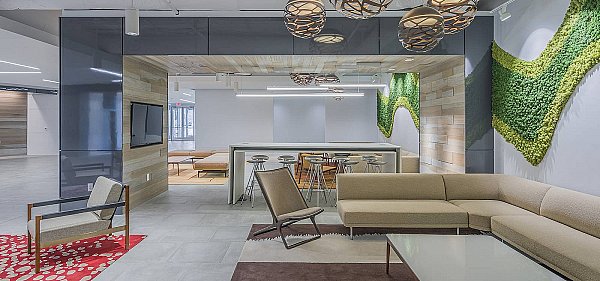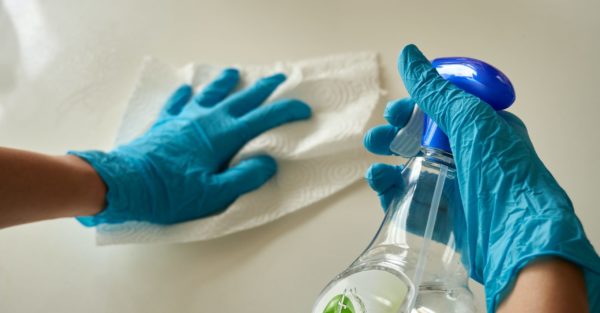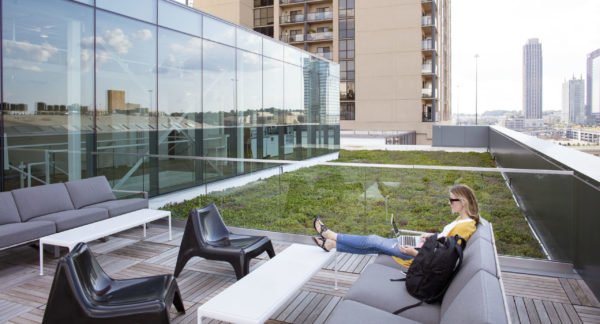News
Fitwel Strategies to Support the Fight Against COVID-19: Leveraging Buildings
June 24, 2020

COVID-19 is thought to spread from person to person, mainly through respiratory droplets produced when an infected person coughs, sneezes, or talks. These droplets can land in the mouths or noses of people who are nearby or possibly be inhaled into the lungs. Spread is more likely when people are in close contact with one another (within about 6 feet). – Centers for Disease Control and Prevention
We have watched coworkers transform living rooms, spare bedrooms, and dining rooms into home offices in an extraordinary effort to redefine “business as usual.” As companies navigate ways to safely reopen offices, they are implementing new measures to support the health and well-being of their employees as they return.
Fitwel was developed by the CDC and the GSA and is not affiliated with the International WELL Building Institute (IWBI). But by subscribing to either system, building owners and corporate tenants can gain a competitive advantage in the race for the best talent. Fitwel is operated by the Center for Active Design (CfAD), a non-profit entity and measures health within 12 areas of design and operations: Location, Building Access, Outdoor Spaces, Entrances and Ground Floor, Stairwells, Indoor Environment, Workspaces, Shared Spaces, Water Supply, Cafeterias and Prepared Food Retail, Vending Machines and Snack Bars, and Emergency Procedures.
CfAD was launched by Mayor Michael Bloomberg in 2012, to transform New York City’s groundbreaking Active Design program into an international movement. Over the last eight years their work has gone global to over 180 countries and supporting the design of buildings and public infrastructure projects around the world.
In the first of a three-part series, we will examine applicable strategies from Fitwel around key themes that highlight how organizations can approach prevention and preparedness as it relates not only to COVID-19 but to other respiratory infections, including cold and flu. The first theme we will examine is six ways owners and tenants can leverage buildings to mitigate viral transmission.
Part II: Density for People | Part III: Getting Certified
6 Ways to Leverage Buildings to Mitigate Viral Transmission
Below is an overview of strategies to mitigate transmission of COVID19, including physical interactions, handwashing, regular cleaning, ventilation, filtration, and humidity.
1.Limit Physical Interactions: Even as our workplaces begin to open, there still needs to be a level of social distancing. Remote work, staggered schedules, and providing PPE to employees who work in close proximity to each other.
2. Cleaning: Thorough cleaning strategies are a major defense against the spread of COVID19, particularly on high touchpoints like doorknobs, light switches, kitchen and bathroom faucets, and breakroom cabinets and refrigerators. There is strong evidence to support that thorough and consistent cleaning protocols reduce infection rates. COVID19 and other viruses can be inactivated by a range of disinfectants. A resource called, Green Seal (who pioneered the ecolabeling movement), provides guidance on how to disinfect safely. Did you know disinfection should always take place last, to ensure that any germs leftover after cleaning are destroyed? Disinfectants are not as effective when applied directly to dirty surfaces, because germs and viruses can hide under soils.

3.Handwashing Signage: Signage encourages positive changes in behavior and these messages, research has shown, increases compliance.
4. Ventilation: Ventilation is especially effective when it comes to preventing aerosol transmission. Available data suggests that lower ventilation rates are associated with increased inflammation and respiratory infections.
“One model looking at how ventilation could prevent aerosol transmission, suggests that diseases transmitted by droplet nuclei, such as influenza, having good ventilation would be as impactful as vaccinating 50-60% of the population in a poor ventilation scenario.” (Smieszek, T., Lazzari, G., & Salathé, M. (2019). Assessing the Dynamics and Control of Droplet-and Aerosol-Transmitted Influenza Using an Indoor Positioning System. Scientific Reports.)
5. Filtration: When operating at full potential high-efficiency particulate air (HEPA) filters can remove 99.97% of particles that are 0·3 microns or larger. HEPA filters remove dust, vapors, bacteria, and fungi, and also effectively capture viral particles spread by droplet nuclei. Note that filtration is part of a broader mechanical system and should not be relied on alone to prevent viral transmission but rather in context with the whole building system. For more filtration information, visit ASHRAE.
6. Humidity: Viruses spread faster in less humid conditions because droplets in dry air evaporate more quickly and fall to the ground more slowly. This means that more humid environments are less hospitable to virus transmission and survival.
“Evidence indicates that maintaining indoor humidity between 40% and 60% is associated with a significant reduction in the infectivity of an aerosolized virus.” (Noti, J. D., et al. (2013). High humidity leads to loss of infectious influenza virus from simulated coughs. PLoS One)

